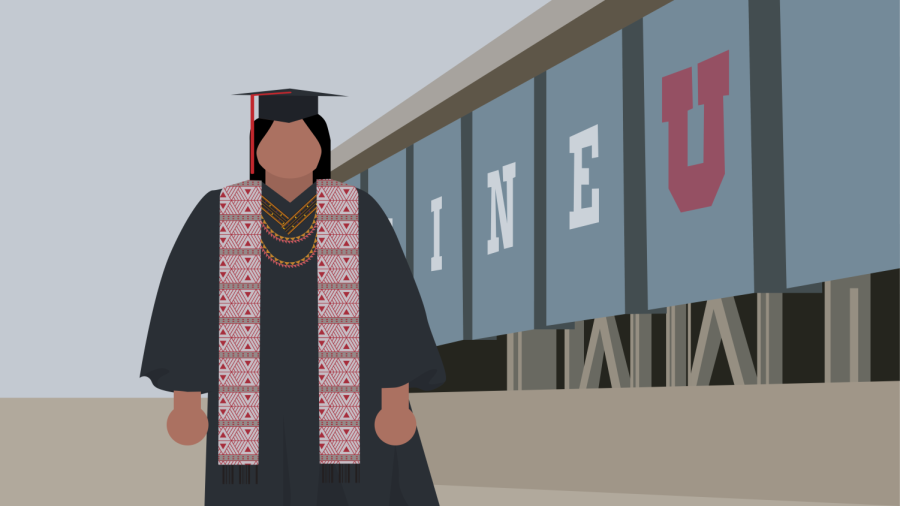Scholarships & Support Systems: A Closer Look at the U’s Outreach to Indigenous Students
(Design by Claire Peterson | The Daily Utah Chronicle)
June 12, 2023
According to the Postsecondary National Policy Institute, only 15.4% of American Indian or Alaska Native residents aged 25 or over had earned a bachelor’s degree in 2021, compared to the national rate of 32.9%.
University of Utah data shows that on average, 120 students who identify as American Indian or Alaska Native enroll each year. Meanwhile, enrollment overall continues to grow, with 6,100 new students expected to enroll in fall 2023. In an effort to reach more Indigenous students, the U announced the beginning of the Native Student Scholarship in July 2022.
Native Student Scholarship Provides Tuition Waiver
The Native Student Scholarship awards students from Utah’s federally recognized tribes with scholarships that cover tuition and mandatory fees. According to U Communications Manager Shawn Wood, 53 students applied and qualified for the scholarship in spring 2023 and $114,368 was awarded in total.
Samantha Eldridge, director of the U’s American Indian Resource Center, expressed the need for the scholarship, calling financial barriers the “number one challenge” for students who come from a marginalized background.
“The scholarship was created to support our Native students the way they said they needed to be supported and to also create greater access to higher education, especially to a group of students who have a lower high school graduation rate and are also a lower enrollment rate across higher education in general,” Eldridge said.
Eldridge added there is also work to be done beyond enrollment so that Indigenous students continue to feel supported during their time at the U. She mentioned recruitment of Indigenous faculty, as well as incorporating Indigenous narratives into the curriculum, as important avenues.
“Thinking about when they step on campus, how are we also supporting those students, making them feel welcomed, making sure that they feel like they belong … that they are seen and represented in faculty and staff, and that the curriculum also reflects our Indigenous history,” Eldridge said.
The American Indian Resource Center, Eldrige said, aims to provide that “academic, personal and cultural support” through a variety of resources for Native students, including tutoring and mentorship.
“Our other focuses include post-graduation success so that once students are graduating that they are able to transition into careers faster and smoother, so making those preparations prior to graduation,” Eldridge said.
The Native Student Scholarship also provides access to resources that support students during their time at the U. According to Eldridge, all students that receive the Native Student Scholarship will be recognized as Native Excellence Scholars. The Native Excellence Program is a program that incorporates academic resources, financial support and community events.
Eldridge also highlighted other programs at the U, such as the Centering Indigenous Reciprocity, Culture, Leadership & Engagement Program, which is dedicated to topics including improving retention rates for Indigenous students and aiding in graduation and degree attainment, as well as cultivating culture, community activities and service projects.
This spring, the students in the CIRCLE Program partnered with the sustainability office at the U to work on the edible campus gardens.
“Our students this semester are engaged in renaming the Pioneer Garden,” Eldridge said. “Right now they are working on the garden and looking at indigenous seeds that they can plant or identifying plants native to Utah, so bringing it back to our culture and traditions, as well as reclaiming spaces.”
Eldridge said she is excited about the Native Student Scholarship, but hopes the U continues to expand its efforts, as the scholarship only covers full-time undergraduate students.
“Moving forward, we would like to expand that to include potentially graduate and professional students,” Eldridge said. “For me, it’s a great launching point but there’s still a lot more we can be doing.”
U Admissions Partner with College Horizons and Equity, Diversity & Inclusion
Recently, the U also partnered with College Horizons, a non-profit organization that works with Indigenous students in high school to help them achieve their academic endeavors. John Marfield, executive director of enrollment at the U, and Meghan Grandolfo, deputy director of admissions, explained that this collaboration aimed to attract more students from these backgrounds to the U.
“Every summer they [College Horizons] host two week-long conferences for high school seniors who are thinking about starting the college-going process,” Grandolfo said. “The students go for the week, they live on campus … and they take different workshops [like] how to apply to college, essay writing workshops.”
The College Horizons program offers advising and connections to their partnering universities to help students with both their goals and their finances. Each summer, the program hosts a five-day conference where students have the opportunity to inquire about college and meet with college counselors, educational partner volunteers, and partnering universities of the College Horizons program.
Grandolfo said College Horizons offers outreach to Indigenous students who want to attend college and connects them with a cultural community that will be with them throughout their college education.
“At the end, there is an opportunity for students to showcase their culture and their identities … it is also an incredible opportunity for staff and faculty who get to go and learn and for students who get a dedicated experience to learn about that college-going culture,” Grandolfo said.
The U’s Office of Admissions has also made efforts to work with the Inter-Tribal Student Association (ITSA) and the department of Equity, Diversity and Inclusion (EDI) to help promote recruitment for the cultural organizations on campus.
“Our ITSA program is a small group but I think we are really excited with the diversity of attendance this year in particular, because usually it’s just from very local students, but we had people from as far as Basin coming to campus and participating in the conference,” Marfield said.
Marfield said the office of admissions has taken on more of the responsibility of organizing these events over the last couple of years so that organizations like ITSA can focus their energy and funding on the programming itself rather than recruitment.
“When I arrived, I realized that a lot of the cultural organizations were using all of their own funding to recruit students to come to campus,” Marfield said. “We work on the logistics and setting up recruitment events, and have them starring the cultural organizations and have them focus on creating the content … we work with EDI to make sure that we can all focus on the areas that we work on.”









